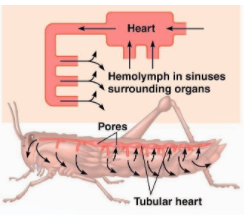
Open circulatory system is present in
A) Arthropods
B) Annelids
C) Chordates
D) Molluscs
a) III only
b) III and II only
c) I and II only
d) I only
Answer
579.9k+ views
Hint: The organisms that have an open type of circulatory system generally have hemolymph instead of blood which functions as blood and the circulatory and digestive functions are performed in a common body cavity.
Complete answer:
All Arthropods have an open type of circulatory system because it requires less energy for distribution and is more suited to animals that have a slower metabolism and a smaller body. As the arteries are absent in this circulatory system, the fluid flows with low blood pressure, and a longer time is taken by the oxygen reaching the cells in the body. Low blood pressure enables these organisms to live even at great ocean depths because pressure change does not have any negative impact on the life of these organisms. Also, due to the presence of a tracheal system, the oxygen is delivered to the maximum parts of the body through a series of tubes, and the oxygen demand through the body fluid is considerably low. The open circulatory system in an arthropod has been shown in the figure below -

It can be seen in the figure that in this type of circulatory system, hemolymph is pumped by a heart in the body cavities where the tissues are surrounded by the hemolymph and then it diffuses back to the heart. There is a sluggish flow of fluid in this system.
So, the correct answer is ‘I only’.
Note:
- Annelids and chordates have closed types of circulatory systems.
- Mollusks belonging to Cephalopoda class like Octopus, Squid, etc. have closed types of circulatory systems but other mollusks have an open type of circulatory system.
Complete answer:
All Arthropods have an open type of circulatory system because it requires less energy for distribution and is more suited to animals that have a slower metabolism and a smaller body. As the arteries are absent in this circulatory system, the fluid flows with low blood pressure, and a longer time is taken by the oxygen reaching the cells in the body. Low blood pressure enables these organisms to live even at great ocean depths because pressure change does not have any negative impact on the life of these organisms. Also, due to the presence of a tracheal system, the oxygen is delivered to the maximum parts of the body through a series of tubes, and the oxygen demand through the body fluid is considerably low. The open circulatory system in an arthropod has been shown in the figure below -

It can be seen in the figure that in this type of circulatory system, hemolymph is pumped by a heart in the body cavities where the tissues are surrounded by the hemolymph and then it diffuses back to the heart. There is a sluggish flow of fluid in this system.
So, the correct answer is ‘I only’.
Note:
- Annelids and chordates have closed types of circulatory systems.
- Mollusks belonging to Cephalopoda class like Octopus, Squid, etc. have closed types of circulatory systems but other mollusks have an open type of circulatory system.
Recently Updated Pages
Master Class 12 Business Studies: Engaging Questions & Answers for Success

Master Class 12 Economics: Engaging Questions & Answers for Success

Master Class 12 English: Engaging Questions & Answers for Success

Master Class 12 Maths: Engaging Questions & Answers for Success

Master Class 12 Social Science: Engaging Questions & Answers for Success

Master Class 12 Chemistry: Engaging Questions & Answers for Success

Trending doubts
What is meant by exothermic and endothermic reactions class 11 chemistry CBSE

Which animal has three hearts class 11 biology CBSE

10 examples of friction in our daily life

One Metric ton is equal to kg A 10000 B 1000 C 100 class 11 physics CBSE

1 Quintal is equal to a 110 kg b 10 kg c 100kg d 1000 class 11 physics CBSE

Difference Between Prokaryotic Cells and Eukaryotic Cells




